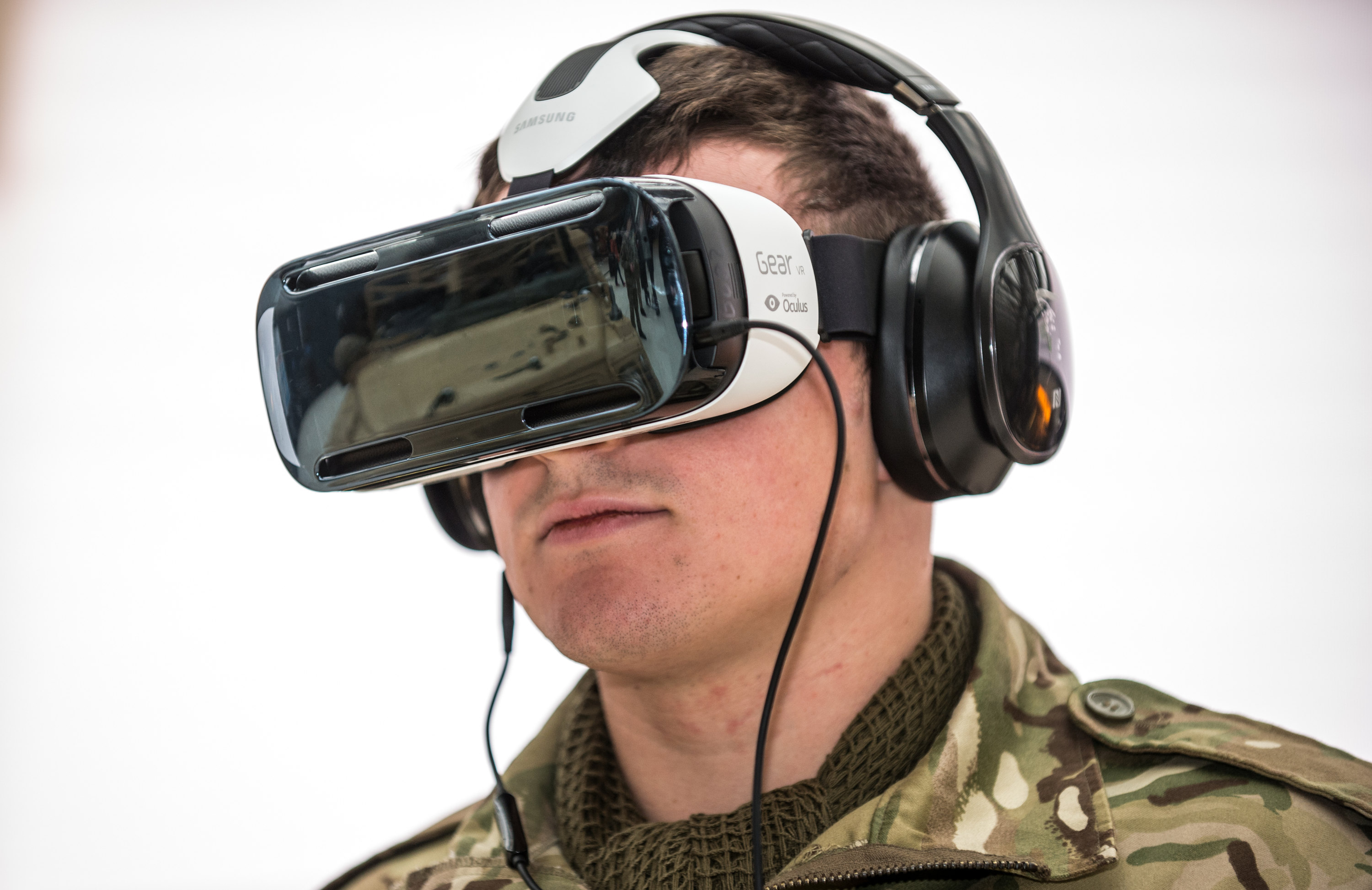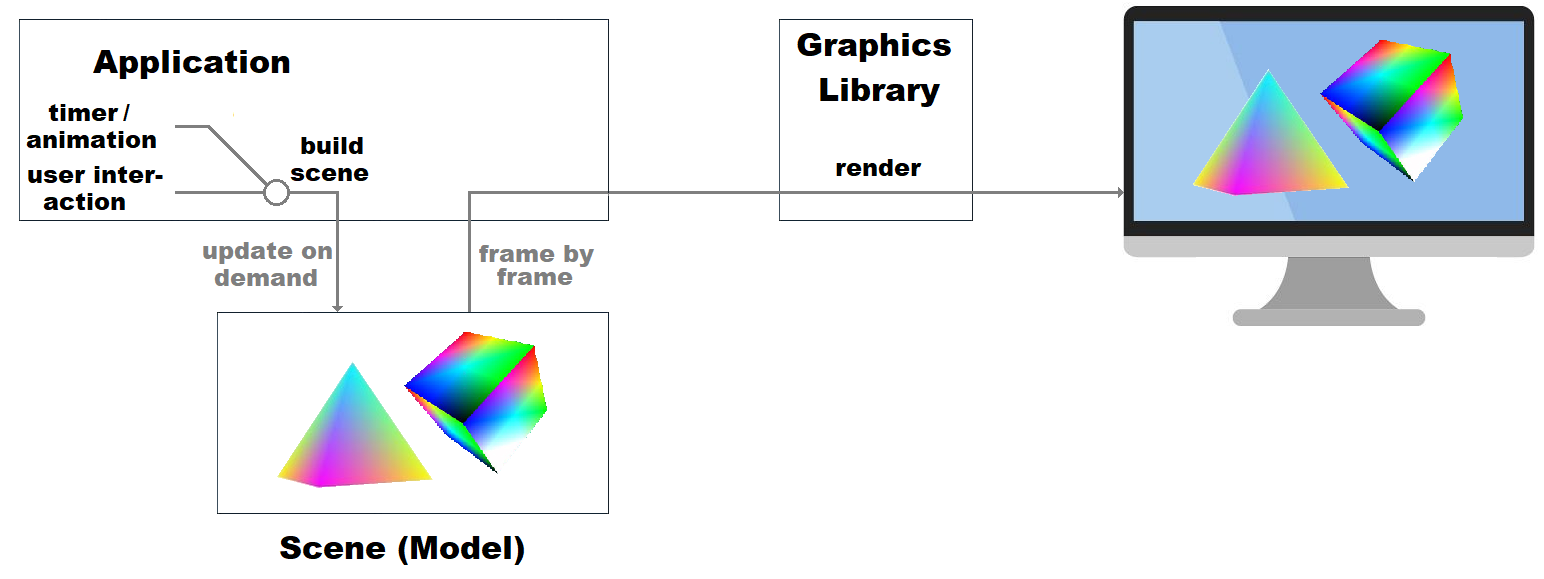|
Java 3D
Java 3D is a scene graph-based 3D application programming interface (API) for the Java platform. It runs on top of either OpenGL or Direct3D until version 1.6.0, which runs on top of Java OpenGL (JOGL). Since version 1.2, Java 3D has been developed under the Java Community Process. A Java 3D scene graph is a directed acyclic graph (DAG). Compared to other solutions, Java 3D is not only a wrapper around these graphics APIs, but an interface that encapsulates the graphics programming using a true object-oriented approach. Here a scene is constructed using a scene graph that is a representation of the objects that have to be shown. This scene graph is structured as a tree containing several elements that are necessary to display the objects. Additionally, Java 3D offers extensive spatialized sound support. Java 3D and its documentation are available for download separately. They are not part of the Java Development Kit (JDK). History Intel, Silicon Graphics, Apple, and Sun al ... [...More Info...] [...Related Items...] OR: [Wikipedia] [Google] [Baidu] |
Sun Microsystems
Sun Microsystems, Inc., often known as Sun for short, was an American technology company that existed from 1982 to 2010 which developed and sold computers, computer components, software, and information technology services. Sun contributed significantly to the evolution of several key computing technologies, among them Unix, Reduced instruction set computer, RISC processors, thin client computing, and virtualization, virtualized computing. At its height, the Sun headquarters were in Santa Clara, California (part of Silicon Valley), on the former west campus of the Agnews Developmental Center. Sun products included computer servers and workstations built on its own Reduced instruction set computer, RISC-based SPARC processor architecture, as well as on x86-based AMD Opteron and Intel Xeon processors. Sun also developed its own computer storage, storage systems and a suite of software products, including the Unix-based SunOS and later Solaris operating system, Solaris operating s ... [...More Info...] [...Related Items...] OR: [Wikipedia] [Google] [Baidu] |
Java Development Kit
The Java Development Kit (JDK) is a distribution of Java technology by Oracle Corporation. It implements the Java Language Specification (JLS) and the Java Virtual Machine Specification (JVMS) and provides the Standard Edition (SE) of the Java Application Programming Interface (API). It is derivative of the community driven OpenJDK which Oracle stewards. It provides software for working with Java applications. Examples of included software are the Java virtual machine, a compiler, performance monitoring tools, a debugger, and other utilities that Oracle considers useful for Java programmers. Oracle releases the current version of the software under the Oracle No-Fee Terms and Conditions (NFTC) license. Oracle releases binaries for the x86-64 architecture for Windows, macOS, and Linux based operating systems, and for the aarch64 architecture for macOS and Linux. Previous versions supported the Oracle Solaris operating system and SPARC architecture. Oracle's primary implementat ... [...More Info...] [...Related Items...] OR: [Wikipedia] [Google] [Baidu] |
Cg Programming Language
The High-Level Shader Language or High-Level Shading Language (HLSL) is a proprietary shading language developed by Microsoft for the Direct3D 9 API to augment the shader assembly language, and went on to become the required shading language for the unified shader model of Direct3D 10 and higher. HLSL is analogous to the GLSL shading language used with the OpenGL standard. It is very similar to the Nvidia Cg shading language, as it was developed alongside it. Early versions of the two languages were considered identical, only marketed differently. HLSL shaders can enable profound speed and detail increases as well as many special effects in both 2D and 3D computer graphics. HLSL programs come in six forms: pixel shaders (fragment in GLSL), vertex shaders, geometry shaders, compute shaders, tessellation shaders (Hull and Domain shaders), and ray tracing shaders (Ray Generation Shaders, Intersection Shaders, Any Hit/Closest Hit/Miss Shaders). A vertex shader is executed for ea ... [...More Info...] [...Related Items...] OR: [Wikipedia] [Google] [Baidu] |
GLSL
OpenGL Shading Language (GLSL) is a high-level shading language with a syntax based on the C programming language. It was created by the OpenGL ARB (OpenGL Architecture Review Board) to give developers more direct control of the graphics pipeline without having to use ARB assembly language or hardware-specific languages. Background With advances in graphics cards, new features have been added to allow for increased flexibility in the rendering pipeline at the vertex and fragment level. Programmability at this level is achieved with the use of fragment and vertex shaders. Originally, this functionality was achieved by writing shaders in ARB assembly language – a complex and unintuitive task. The OpenGL ARB created the OpenGL Shading Language to provide a more intuitive method for programming the graphics processing unit while maintaining the open standards advantage that has driven OpenGL throughout its history. Originally introduced as an extension to OpenGL 1.4, G ... [...More Info...] [...Related Items...] OR: [Wikipedia] [Google] [Baidu] |
Cave Automatic Virtual Environment
A cave automatic virtual environment (better known by the recursive acronym CAVE) is an immersive virtual reality environment where projectors are directed to between three and six of the walls of a room-sized cube. The name is also a reference to the allegory of the Cave in Plato's ''Republic'' in which a philosopher contemplates perception, reality, and illusion. The CAVE was invented by Carolina Cruz-Neira, Daniel J. Sandin, and Thomas A. DeFanti at the University of Illinois, Chicago Electronic Visualization Laboratory in 1992. The images on the walls were in stereo to give a depth cue. General characteristics A CAVE is typically a video theater situated within a larger room. The walls of a CAVE are typically made up of rear-projection screens, however large-scale LED displays are becoming more common. The floor can be a downward-projection screen, a bottom projected screen, or a flat panel display. The projection systems are very high-resolution due to the near ... [...More Info...] [...Related Items...] OR: [Wikipedia] [Google] [Baidu] |
Head-mounted Display
A head-mounted display (HMD) is a display device, worn on the head or as part of a helmet (see helmet-mounted display for aviation applications), that has a small display optic in front of one (monocular HMD) or each eye (binocular vision, binocular HMD). HMDs have many uses including gaming, aviation, engineering, and medicine. Virtual reality headsets are a type of HMD that track 3D position and rotation to provide a virtual environment to the user. 3DOF VR headsets typically use an Inertial measurement unit, IMU for tracking. 6DOF VR headsets typically use sensor fusion from multiple data sources including at least one IMU. An optical head-mounted display (OHMD) is a wearable display that can reflect projected images and allows a user to see through it. Overview A typical HMD has one or two small displays, with lenses and semi-transparent mirrors embedded in eyeglasses (also termed data glasses), a visor, or a helmet. The display units are miniaturized and may include ... [...More Info...] [...Related Items...] OR: [Wikipedia] [Google] [Baidu] |
Immediate Mode (computer Graphics)
Immediate mode is an application programming interface, API design pattern in computer graphics libraries, in which * the Client (computing), client calls directly cause Rendering (computer graphics), rendering of graphics objects to the display, or in which * the data to describe rendering primitives is inserted Film frame, frame by frame directly from the Client (computing), client into a command list (in the case of ''#Immediate mode primitive rendering, immediate mode primitive rendering''), without the use of extensive indirection – thus'' immediate ''– to retained resources. It does not preclude the use of Multiple buffering, double-buffering. Retained mode is an alternative approach. Historically, retained mode has been the dominant style in Graphical user interface, GUI libraries; however, both can coexist in the same library and are not necessarily exclusive in practice. Overview In immediate mode, the scene (complete object model of the rendering primitives) is ... [...More Info...] [...Related Items...] OR: [Wikipedia] [Google] [Baidu] |
Real-time Computer Graphics
Real-time computer graphics or real-time rendering is the sub-field of computer graphics focused on producing and analyzing images in real time. The term can refer to anything from rendering an application's graphical user interface ( GUI) to real-time image analysis, but is most often used in reference to interactive 3D computer graphics, typically using a graphics processing unit (GPU). One example of this concept is a video game that rapidly renders changing 3D environments to produce an illusion of motion. Computers have been capable of generating 2D images such as simple lines, images and polygons in real time since their invention. However, quickly rendering detailed 3D objects is a daunting task for traditional Von Neumann architecture-based systems. An early workaround to this problem was the use of sprites, 2D images that could imitate 3D graphics. Different techniques for rendering now exist, such as ray-tracing and rasterization. Using these techniques and a ... [...More Info...] [...Related Items...] OR: [Wikipedia] [Google] [Baidu] |
Oracle Corporation
Oracle Corporation is an American Multinational corporation, multinational computer technology company headquartered in Austin, Texas. Co-founded in 1977 in Santa Clara, California, by Larry Ellison, who remains executive chairman, Oracle was the List of the largest software companies, third-largest software company in the world in 2020 by revenue and market capitalization. The company's 2023 ranking in the Forbes Global 2000, ''Forbes'' Global 2000 was 80. The company sells Database, database software, particularly Oracle Database, and cloud computing. Oracle's core application software is a suite of enterprise software products, such as enterprise resource planning (ERP) software, human capital management (HCM) software, customer relationship management (CRM) software, enterprise performance management (EPM) software, Customer Experience Commerce (CX Commerce) and supply chain management (SCM) software. History Larry Ellison, Bob Miner, and Ed Oates co-founded Oracle in ... [...More Info...] [...Related Items...] OR: [Wikipedia] [Google] [Baidu] |
JavaFX
JavaFX is a software platform for creating and delivering desktop applications, as well as rich web applications that can run across a wide variety of devices. JavaFX has support for desktop computers and web browsers on Microsoft Windows, Linux (including Raspberry Pi), and macOS, as well as mobile devices running iOS and Android, through Gluon Mobile. With the release of JDK 11 in 2018, Oracle made JavaFX part of the OpenJDK under the ''OpenJFX'' project, in order to increase the pace of its development. Open-source JavaFXPorts works for iOS (iPhone and iPad) and Android. The related commercial software created under the name "Gluon" supports the same mobile platforms with additional features plus desktop. This allows a single source code base to create applications for the desktop, iOS, and Android devices. Features JavaFX 1.1 was based on the concept of a "common profile" that is intended to span across all devices supported by JavaFX. This approach makes it possible f ... [...More Info...] [...Related Items...] OR: [Wikipedia] [Google] [Baidu] |
Retained Mode
Retained mode in computer graphics is a major pattern of API design in graphics libraries, in which * the graphics library, instead of the client, retains the scene (complete object model of the rendering primitives) to be rendered and * the client calls into the graphics library do not directly cause actual rendering, but make use of extensive indirection to resources, managed thus ''retained'' by the graphics library. It does not preclude the use of double-buffering. Immediate mode is an alternative approach. Historically, retained mode has been the dominant style in GUI libraries; however, both can coexist in the same library and are not necessarily exclusionary in practice. Overview In retained mode the client calls do not directly cause actual rendering, but instead update an abstract internal model (typically a list of objects) which is maintained within the library's data space. This allows the library to optimize when actual rendering takes place along wit ... [...More Info...] [...Related Items...] OR: [Wikipedia] [Google] [Baidu] |






